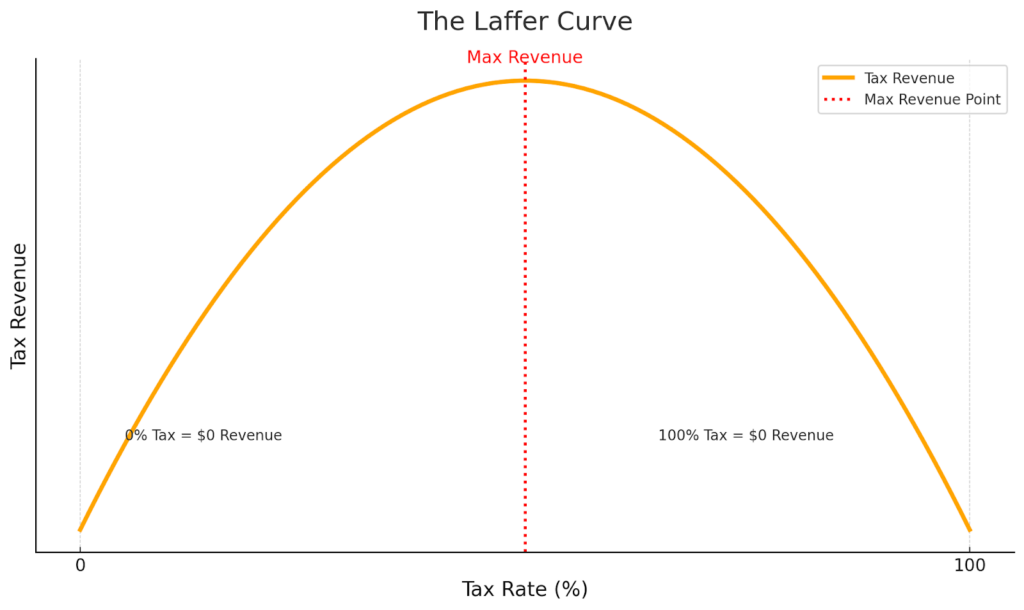What happens when someone asks you a question on a topic that should come with a trigger warning?
You don’t hold back.
At least, I didn’t when I answered the question Philip emailed to [email protected].
And because my thoughts snowballed as I wrote an answer, I decided you’d benefit from reading it as well.
Here’s how it started…
Dear Charles,
I understand that Trump administration’s chief economist Arthur Betz Laffer believes there is an optimal tax rate (below the current rate) that could spur economic activities and growth that would more than compensate for the increasing huge debts.
I also understand that Art has been closely involved in crafting the “Big Beautiful Bill.”
Do you have any input on Art’s assertion?
Regards,
Philip
Well, Philip, thanks for writing.
Art Laffer doesn’t currently have a formal role in Trump’s administration, but he did advise the president in his first term and has been generally supportive of Trump’s economic policies.
Regardless, the “Laffer Curve” is a great way to illustrate supply-side economics.
As the story goes, Laffer sketched it on a cocktail napkin back in the 1980s to explain how Ronald Reagan’s economic policies worked.
While the Laffer Curve is not “provable” in the real world (you can’t test it in a truly controlled experiment), it’s theoretically sound and makes sense.
But you have to put it into context.
It’s a calculus maximization exercise.
If you set tax rates at zero, you get zero tax revenues. If you set the tax rate at 100%, you also get zero tax revenues because no one would work if the government confiscated 100% of their earnings.
So, the optimal tax rate – the rate that brings in the most revenue for the government – is somewhere between 0% and 100%.
What is that exact optimal point?
No one knows. It’s not observable.
But it’s clear that beyond a certain point, higher tax rates don’t lead to higher revenues for the government because economic activity slows.

Lower tax rates will always lead to higher growth. But there are diminishing marginal returns.
Is your behavior going to materially change if the tax rate is lowered from 70% to 30%?
Certainly.
Is your behavior going to change if the tax rate is lowered from 35% to 33%?
That’s harder to say. The difference might not be large enough to move the needle.
So, all else equal, Trump’s tax cuts will increase growth.
But how much?
Trump’s original tax cuts back in 2017 lowered the effective average tax rate from 14.4% to 13.0%.
That’s small compared to the John F. Kennedy and Ronald Reagan tax cuts.
Unsurprisingly, we didn’t see a major bump to GDP or to tax receipts. During the four years of Trump’s first term, GDP growth never made it above 3%.
Growth and Debt
The Big Beautiful Bill will generate growth. But it isn’t realistically going to generate enough growth to slow our debt problem, let alone fix it.
The budget deficit is at 6% of GDP. Just to stay even, we’d need to grow the economy by 6%. To make progress, we’d have to grow significantly higher than that.
That’s not going to happen.
We haven’t had growth at those levels for a sustained period since the 1960s, when we were in the middle of a post-war, post-Great-Depression boom.
The only way out of this debt grave is to cut spending by something in the ballpark of $2 trillion.
Trump has no plans to do that.
Neither did Joe Biden, Kamala Harris, or any other president of our lifetimes.
Due to its increase in overall government spending, the Big Beautiful Bill gets us just that much closer to a nasty day of reckoning.
That’s why it’s our mission at the Freeport Society to help you prepare by putting in place hedges against a collapsing dollar, protecting your wealth and investments using well thought out and proven strategies, and growing your wealth by embracing the chaos.
In our flagship Freeport Investor newsletter, we’re doing well in these efforts.
Our gold positions are up 62%, 53%, and 6%. Our Bitcoin positions are up 182% and 82%. Our position in silver is up 17%.
In fact, at risk of angering the market gods, all positions in our model portfolio are showing open gains.
So, how do you use this discussion about taxes, growth, and debt?
Quite simply, own gold.
As I discussed recently, there are several forms you can do this in: physical gold, mining company stocks, or exchange traded funds (ETFs).
If your risk tolerance is low, hold physical gold like I do.
If you’d prefer not to incur the added expense of doing that, invest in an ETF like the SPDR Gold MiniShares (GLDM). This also gives you more flexibility when it comes to selling or adding exposure.
If you are more willing to take on some risk, investing in gold miners is a good option for you.
Perhaps it’s worth having a little of each of these types of gold investments in your portfolio.
Regardless, keep reading Freeport Navigator.
We’ve got your back.
To life, liberty, and the pursuit of wealth.
P.S. If you have any burning questions you’d like to ask me, I’m all ears. Send them to [email protected].
